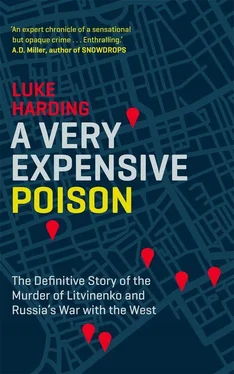In the wake of Litvinenko’s murder, Russian officials said that any nuclear research reactor was capable of making the isotope. There are about thirty research reactors worldwide. But again the amount that could be generated was far smaller than the amount of polonium put in Litvinenko’s tea – mere picograms, at least 20,000 times smaller than the dose that killed him, via cell death in his body tissue and organs.
Dombey’s conclusions – made public in 2015 – were succinct. He wrote:
a) The Po-210 used to poison Mr Litvinenko was made at the Avangard facility in Sarov, Russia. One of the isotope-producing reactors at the Mayak facility in Ozersk, Russia, was used for the initial irradiation of bismuth.
b) In my opinion the Russian state or its agents were responsible for the poisoning.
Dombey believed it was ‘highly unlikely’ that the reactor used to irradiate the bismuth was in Sarov. None of the reactors there had a sufficiently high neutron flux. Instead it began its journey to London from the Mayak facility near Chelyabinsk.
Litvinenko was undoubtedly Mayak’s most spectacular victim. But there were thousands of anonymous others in Chelyabinsk province and beyond who were consigned to agonising leukemias and premature deaths. Their suffering played out at home and in hospitals, largely unnoticed, beyond a small circle of family and friends, before an indifferent world.
* * *
The operation to kill Litvinenko was complex, covert and extra-territorial. It involved an esoteric nuclear poison, two hand-picked – if incompetent – assassins and a logistics chain that stretched from the Ural mountains via several intermediary points to the streets of London’s Mayfair.
It was also full of hazards. As part of his investigation, Dombey examined previous cases of polonium poisoning. In 1925, Nobus Yamada, a Japanese scientist who had been working at the Curies’ laboratory in Paris, fainted suddenly on his return to Japan. He had been handling polonium. Yamada died eighteen months later. In the summer of 1927, a Polish researcher, Sonia Cotelle, who had also been preparing polonium, suffered severe side effects. The Curies’ daughter Irene wrote that Cotelle was in ‘very bad health’, had stomach problems and had experienced ‘a very rapid loss of hair’. She carried on working for several years until a vial of polonium shattered in her face. She died two weeks later.
These were accidents, but Litvinenko’s death was deliberate. Given polonium’s rapid decay, the dose used to kill him must have been made in a relatively brief period before his killers travelled to London.
Dombey said: ‘Whoever poisoned Mr Litvinenko and brought polonium to Britain would only have done it if it had been tested in advance, because polonium is so radioactive that if they got their numbers wrong it wouldn’t work.’ He went on: ‘On the higher side it could have produced a major public health problem.’
With little data to go on, Dombey asked a colleague to check if there were any suspicious deaths in Russia with the same symptoms as Litvinenko’s? The colleague said there were. He mentioned two similar cases. The Russian press had featured both of them.
The first involved a Chechen guerrilla commander called Lecha Ismailov. Ismailov was captured, put in Lefortovo Prison, and tried. He got nine years. According to Akhmed Zakayev, Russia’s spy agencies put pressure on Ismailov to switch sides. He refused their offer to work for the FSB.
On the morning of his transfer from Lefortovo to a regular jail, the two people who had failed to recruit Ismailov summoned him for a friendly chat. They suggested he drink a farewell cup of tea. They also offered him a snack. Ismailov drank the tea. He began to feel ill after five minutes, as warders took him to his cell. He was moved to a hospital in Volgograd, where his Litvinenko-like symptoms – hair loss and massive blisters – bewildered doctors there. Twelve days later he was dead. His relatives told journalists they suspected Russia’s security agencies may have poisoned him.
The other possible precedent involved a figure from Vladimir Putin’s early years in St Petersburg, Roman Tsepov. In the 1990s, Tsepov worked as a bodyguard for Putin and for the city’s mayor Anatoly Sobchak. Allegedly, he was the liaison between politicians and the Tambov crime gang. Tsepov co-founded a private security company, Baltic-Escort. His partner was Viktor Zolotov, the future head of Putin’s personal bodyguard. According to some accounts, Zolotov was the president’s brutal enforcer and an individual of enormous physical strength.
Tsepov had friends in high places. And, unfortunately perhaps, he knew their secrets too well. In September 2004, he stopped by at the local FSB office for a cup of tea. He fell violently ill. He was admitted to Hospital No. 31 in St Petersburg, an institution that formerly treated the communist elite. Tsepov’s symptoms were unusual: vomiting and diarrhoea but also a catastrophic fall in white blood cells. He died shortly afterwards.
The investigative paper Novaya Gazeta quoted sources in the St Petersburg prosecutor’s office who said a post-mortem examination revealed ‘high quantities’ of radioactive contamination in Tsepov’s body. This wasn’t told to law-enforcement bodies. No cause of death was established.
Dombey’s report traced the source of the polonium to Mayak, in the form of irradiated bismuth. From Mayak it went to Sarov. But one link in the chain was missing. The polonium made on Sarov’s production line was in metallic form. Sealed in a special container, it was difficult to extract. The polonium used to kill Litvinenko, by contrast, was soluble.
According to Dombey, a ‘state organisation’ would need to convert the metallic polonium to soluble polonium. Only then could it be deployed.
That the KGB had its own specialist poisons laboratory was a well-established fact. Numerous former officers – some retired, some defectors – had confirmed its existence.
Pavel Sudoplatov, the former chief of Stalin’s foreign-intelligence service, who coordinated the atomic espionage operation against the US and Britain, mentions the lab in his 1994 memoir, Special Tasks. The poisons factory was set up in 1921. It went through several changes. Its core function – experimenting with poisons and other lethal substances on behalf of the state – remained the same.
Western intelligence experts believe its efforts were originally directed towards using poison on the battlefield. Tests were unsuccessful. The KGB concluded that poisons were better used to eliminate individuals.
The KGB had a track record of killing in Britain. Oleg Kalugin, a former high-ranking KGB officer and defector, now living in the US, said that the KGB’s poisons unit was involved in one of the most notorious murders of the Cold War. In September 1978, the Bulgarian dissident and writer Georgi Markov was waiting for a bus at Waterloo Bridge in London. He was on his way to his job at the BBC. Markov felt a sharp pain on his leg from what he thought was an insect bite; next to him he saw a man stooping to pick up a dropped umbrella.
Markov’s assassin had fired a pellet of ricin into Markov’s leg from close range. Four days later he was dead. According to Kalugin, the then head of the KGB, Yuri Andropov, agreed to a request from the Bulgarian security services to facilitate the assassination. Kalugin told Radio Free Europe: ‘Through the KGB laboratory we transferred the poison that was used in the umbrella. There was literally a milligram of poison, a small drop of ricin placed in a capsule at the tip of the umbrella.’
In the 1980s, the KGB’s lab was still operational. Litvinenko’s co-author Yuri Shvets, at the time an upwardly mobile KGB colonel, recalls meeting a laboratory staffer in Moscow. Against Shvets’s judgement, his KGB bosses had decided to use a truth-telling drug on his American source, codenamed ‘Socrates’. The secret KGB laboratory was at No. 1 Academician Varga Street, in south-west Moscow.
Читать дальше












